Liverpool has always had a fascination for me and there are a number of posts in this blog about Merseyside and the Wirral, starting with the 2009 post Liverpool.
Although most of my trips to Liverpool are undocumented, a few of my journeys are outlined in this blog. I've written about various journeys by train via Crewe:-
'Black 5' to Birmingham (1950s steam).On Saturday, 8th March 2014 I decide to make another trip to Liverpool, this time by a more unusual route.
Day Trip to Liverpool (2010 EMU).
Liverpool by Train (2012 EMU).
I started by re-tracing the route I'd used on my earlier trip to Chirk, described here. Once again, this involved taking an Arriva DMU from Wolverhampton to Shrewsbury, using a 'semi-fast' train only stopping at Telford and Wellington.
Shrewsbury
At Shrewsbury, I planned to change onto an Arriva Trains Wales service from Cardiff to Holyhead. The train was reported as a few minutes late and I was surprised to find that it would use platform 3, which I didn't think was much used. Getting to platform 3 was a bit odd. We'd arrived on bay 5 which is part of the island platform comprising through platforms 4 and 7 together with bays 5 and 6. Exit from this island platform was via broad stairs down to a subway leading to a series of automatic ticket barriers. Access to platform 3 wasn't obvious but a ticket inspector at the barrier seemed to be letting some passengers through. When I enquired, he waved me through, telling me to pass through the ticket hall, turn left and go up the stairs. The small ticket hall was thronged with passengers entering and leaving but I was reassured by a sign pointing left to platform 3. I continued onto the station forecourt, puzzled for a moment until I saw an anonymous set of open double doors with steps leading upwards. It was rather confusing but I'd apparently found platform 3.
 The imposing ashlar-faced facade of Shrewsbury station, viewed from the forecourt.
The imposing ashlar-faced facade of Shrewsbury station, viewed from the forecourt.
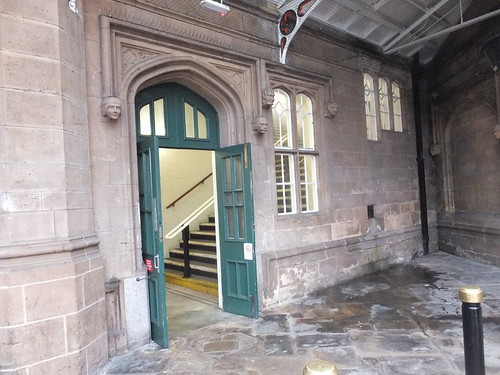 The impressive, but rather anonymous, entrance to platform 3 from the forecourt.
The impressive, but rather anonymous, entrance to platform 3 from the forecourt.
The train was a few minutes late so I still had time for a few photographs. The design of the station building on platform 3 (the earliest part of the station) I found most attractive. The detailing I'd found on the elevation facing the forecourt is continued on the platform face. It was no surprise to find the building listed Grade II, but I was surprised to find it was by Thomas Penson Junior, whose station at Gobowen (in Italianate style) I'd previously admired. See the entry on the British Listed Buildings site.
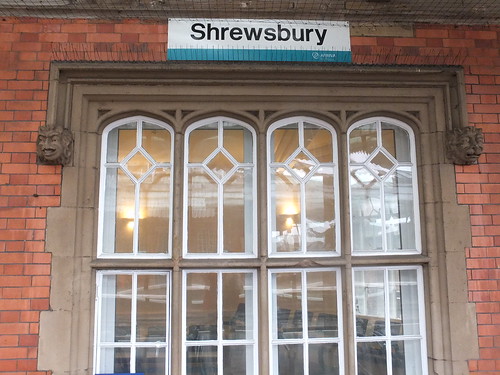 Window to waiting room on platform 3.
Window to waiting room on platform 3.
 Crewe Junction, Shrewsbury, viewed from platform 3.
Crewe Junction, Shrewsbury, viewed from platform 3.
The train arrived, people alighted and boarded and we departed with a well-filled train about ten minutes late. On this trip, I managed a (rather poor) shot of Coton Hill North Signal Box, long disused and converted into a private house with modern extensions to one side and at the rear.
 Coton Hill North Signal Box now forms part of a private house.
Coton Hill North Signal Box now forms part of a private house.
Gobowen
Approaching Gobowen, I was a little surprised to pass a modern LED signal displaying a double yellow, followed by another LED signal showing single yellow. I assumed that the intention was to give drivers the best possible warning before the semaphore signal protecting the level crossing at the north end of the platform. At Gobowen, a remarkable number of passengers got off and got on whilst I, once again, admired the Italianate station building by Thomas Penson Junior. I also wondered whether the semaphore signal protecting the level crossing was the ugliest semaphore I'd seen (there's some heavy competition from some of the signals in Burma - see Railway Signalling in Burma - Part 1: Semaphore Signals). A tubular post topped with a Western Region 'ball and spike' finial is fitted with an upper quadrant arm at a fairly low level (to improve sighting, presumably). Although only a few yards from the controlling signal box, Gobowen North, this arm is motor-operated from a motor perched near the top of the post. There are clearly constraints because the signal post is mounted on the platform in a public area but, combined with the usual modernised ladder and hoop access arrangements, the effect is awful.
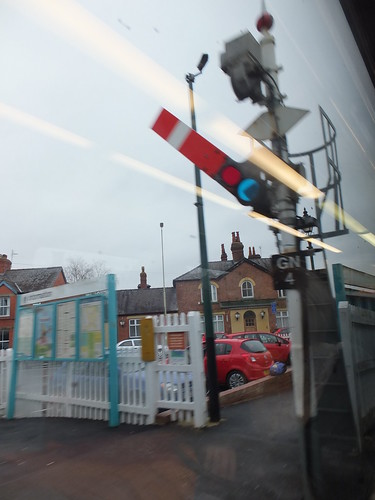
Gobowen North signal 'GN4'.
We paused briefly at Chirk (where I'd disembarked on my previous trip) and then crossed the Dee valley on the impressive viaduct. I'd forgotten how industrialised the area had once been around Ruabon and Brymbo with coal mines, heavy engineering and numerous railway branches to serve them. All gone now, of course.
Wrexham
Soon, we were running into Wrexham General. Logically, I would have stayed on my train until Chester, then caught a Merseyrail service to Birkenhead and Liverpool. There are a series of posts describing travelling on the Merseyrail network, starting with Birkenhead and New Brighton by train (Part 1).
However, my plan was to leave the train at Wrexham General, on the former Great Western Main line to Saltney Junction and Chester, take a few pictures and then travel forward to Bidston on the old Great Central line, now marketed as the 'Borderlands Line'. The Great Central Line ran through its own platforms at Wrexham General, to allow interchange, but then continued to its own station more conveniently sited in the town called Wrexham Central. I knew the remaining single line from Wrexham General to Wrexham Central now operated simply as a 'long siding'. I'd originally hoped to walk from Wrexham General to Wrexham Central, and catch the Bidston train from there but the late-running of the Holyhead train caused me to change my mind so I bought a ticket to Bidston at Wrexham General and settled for a few pictures around the Wrexham General station.
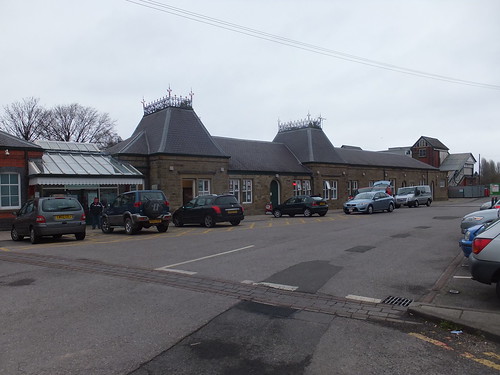 The neat appearance of the station buildings at Wrexham General.
The neat appearance of the station buildings at Wrexham General.
The trackwork around Wrexham General has been significantly simplified over the years and the only remaining signal box in the area is Croes Newydd North Fork Signal Box, a few hundred yards south of Wrexham General station.
 Croes Newydd North Fork Signal Box.
Croes Newydd North Fork Signal Box.
Having taken some pictures, I went to platform 4 which serves the Borderlands Line and found that the next arrival was going to Wrexham Central. A driver and guard were waiting to relieve the incoming crew. So, when the train arrived (a Class 150) I hopped on and got to ride to the very simple station platform at Wrexham Central (or Wrecsam Canolog, if you prefer), sandwiched between the modern buildings of a shopping centre. After a few moments, the driver and guard had changed ends, and we set off for Bidston.
 View of Wrexham Central station from the train.
View of Wrexham Central station from the train.
Borderlands Line
The Borderlands Line currently serves the following stations:-
Wrexham CentralAlthough we were on a single line from Wrexham Central to Wrexham General (where the remains of the disused second platform could be seen), north of the station the original double track is retained. This seems curious, because the old Great Western main line from Wrexham to Saltney Junction has been singled (although there are plans to reinstate double track to increase capacity). I've never thought this singling very sound. In an earlier post Princes End I commented:-
Wrexham General
Gwersyllt
Cefn-y-Bedd
Caergwrle
Hope
Penyffordd
Buckley
Hawarden
Shotton High Level
Harwarden Bridge (peak periods only)
Neston
Heswall
Upton
Bidston
At the time, there was also what seemed to me a rather perverse fashion for reducing track maintenance costs by singling double track sections. I was never convinced that this idea was justified, taking into account the signalling complication at each end of the single line where it rejoined normal double track and the operational problems of having to wait for a train in one direction to clear before a train could pass in the opposite direction.I was quite surprised at the number of passengers we were dropping off and picking up along the line. Approaching Penyffordd, we whistled at three whistle boards in succession and then passed an upper quadrant tubular post distant showing 'off' before stopping at the station. The Home signal was also a tubular post, with a lower left-hand bracket and subsidiary signal controlling facing entry to sidings just after the B.R. standard signal box.
 Penyffordd signal box.
Penyffordd signal box.
The sidings didn't appear to be in use. A little further on, we passed a ground frame controlling access to another group of sidings. A branch curved away towards a modern cement plant but, again, there wasn't much sign that the rail connection was used.
The cement works (formerly Castle Cement but now Hanson, part of the Heidelberg Cement) is called Padeswood Works and there's a little more here. The massive Kiln 4 looks more like an assembly building for a Space Shuttle and its commissioning in 2005 allowed three older kilns on the site to be shut down. The owners proudly claim of Kiln 4:-
Central to the greatly improved performance is the use of alternative fuels, in which we have been a pioneer. Alternative fuels used at Padeswood include Cemfuel, which is processed from the residue of recycled waste solvents; Profuel, which comprises paper and plastic wastes and also MBM which is processed meat and bone meal. Vehicle tyres can also be used as an alternative fuel.Buckley station has what would once have been an impressive station building, now derelict. Nearby, a well-maintained area had a wheelbarrow forming a planter filled with flowers. The wheelbarrow had been painted black and lettered 'LNER' as a reminder of the 'foreign' incursion into this part of Wales and was also chained to the nearby fence as a security precaution.
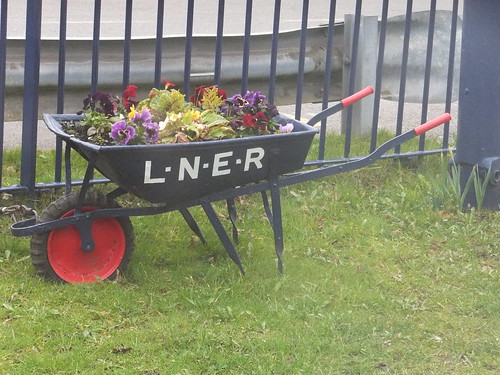 Flowers on Buckley station.
Flowers on Buckley station.
Hawarden station had the usual type of 'bus shelter' for passengers. Next, we took the bridge over the busy Chester Road in Shotton and paused at Shotton High Level station, which sported a rather up-market version of the 'bus shelter' featuring stainless steel. I was intrigued by a box of rodent bait set up on the platform ("Super rats eat stainless steel!" perhaps?). As we started away, we passed over the railway line to Holyhead and Shotton Low Level Station.
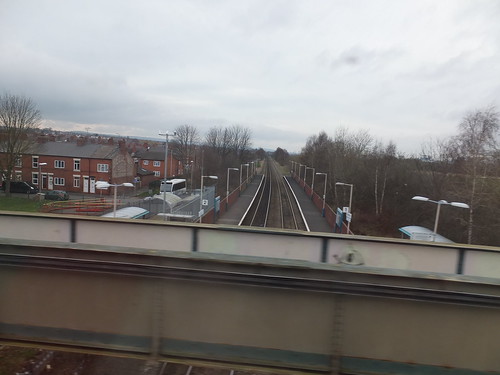 View of Shotton Low Level (looking towards Holyhead) from a Down Bidston train.
View of Shotton Low Level (looking towards Holyhead) from a Down Bidston train.
I'd previously travelled on the line from Shotton High Level to Bidston, years ago. This was the era when the North Wales Coast line had blue diesel-electrics hauling five blue and grey coaches (I think it was one of the last hunting grounds of the Class 40s). I travelled out from Chester to Shotton Low Level on one of these trains, took the footpath to high level and travelled to Bidston on a 'Modernisation' series Diesel Multiple Unit.
Passing through Shotton reminded me of a minor incident on another occasion years ago when I was off to Llandudno for the day - always a favorite destination as mentioned in posts A Trip to the Seaside (Part 1) and Part 2. Not all of the North Wales Coast line trains were booked to stop at Shotton Low Level but I'd noted that the early-morning service I'd chosen was due to stop. On the approach to Shotton, I thought my train was coming in rather 'hot' but then I realised the driver had forgotten the stop. I don't know whether the driver suddenly remembered or the guard 'put the brake in' but we did a rapid deceleration and came to a stop a couple of hundred yards beyond the platform. To my surprise, the train then gently set back to the platform and obediently waited for the guard's 'Right Away'.
Back in the present, as my Class 150 approached the Dee crossing, the sprawling Tata Steel complex came into view on the Wirral side. The history of steelmaking on this site is due to John Summers who, in 1852, established a successful nail making business in Stalybridge. After his death in 1876, three of his sons (later joined by a fourth) carried on the business. Needing space for expansion, they acquired land at Shotton in 1895 and Hawarden Bridge Steelworks opened the following year, later under the name John Summers and Sons Limited. In 1951, the steelworks was nationalised but shortly afterwards re-privatised. I think this is when I first became aware of Shotton's modern 'Integrated Steelworks' (where hot metal produced by a blast furnace is taken directly for processing into steel on the same site). The site was nationalised for a second time in 1967, becoming part of British Steel Corporation. In the 10-year plan for steel approved by the Government in 1973, Shotton was to lose its steelmaking as its blast furnace was regarded as too 'small batch' and its Open Hearth steelmaking as 'too expensive'. In-fighting with the Unions continued until 1980, and there was major local unemployment. To reduce unemployment, part of the site became Deeside Industrial Park. Some steelworking continued and in 1988 the British Steel Corporation was privatised as British Steel. In 1999, British Steel merged with the Dutch steelmaker Koninklijke Hoogovens to form Corus. Corus was acquired by the present owners, Tata Steel, in 2007 and Shotton is now responsible for their pre-finished steel products. There's a brief timeline produced by Tata Steel here.
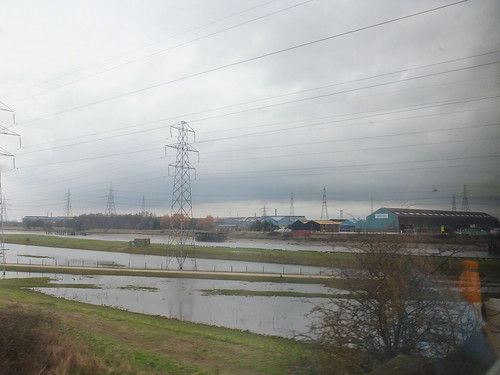 View from Down Bidston train approaching the Dee Crossing with the Tata Steel complex in the background.
View from Down Bidston train approaching the Dee Crossing with the Tata Steel complex in the background.
The double track railway (and a footpath) cross the Dee on a bridge of three spans of arched trusses. The span on the Wirral side was built as a hydraulically operated swing bridge but that's now welded shut. The bridge, opened in 1889 was built by the Manchester, Sheffield and Lincolnshire Railway (later the Great Central Railway). There's more information on the bridge in Chapter 10 of the Shotton History site here. It's only when I was compiling this post I found the Movable Bridges in the British Isles site, which also has some information on the bridge. Well, the view of the bridge I got was rather disappointing. I didn't realise Network Rail had started a 3.5 million pounds Sterling project to strengthen and repaint the bridge which is currently covered in scaffolding and heavy white plastic sheeting whilst sand-blasting to remove old paint is carried out. As the Network Rail News Release puts it, the bridge is "encapsulated to protect the environment from dust and debris from the work".
 Hawarden Bridge before "encapsulation" (Photo: John S. Turner, Creative Commons).
Hawarden Bridge before "encapsulation" (Photo: John S. Turner, Creative Commons).
Only certain trains stop at the tiny station of Hawarden Bridge, so we kept going and passed the signal box at Dee Marsh Jn. This once controlled one corner of a triangular junction with the Great Central Line to Chester which is long gone. Now, provided with a few elderly 2-aspect colour light signals, it controls connections to the extensive sidings around the steel complex.
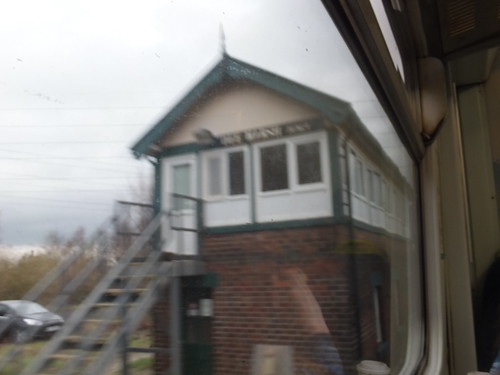 A fuzzy picture of Dee Marsh Junction signal box.
A fuzzy picture of Dee Marsh Junction signal box.
Although there were a few freight wagons scattered around the sidings, the area looks rather barren and neglected. Once we'd left the former steel complex behind, we made our way across the Wirral with stops at Neston, Heswall and Upton before our final destination at Bidston.
Bidston Station has a single island platform on the double-track third-rail electrified Merseyrail Line from Birkenhead North to West Kirby. With four trains an hour each way on the West Kirby line, the Borderlands Line trains have to sneak in out fairly quickly. Approaching Bidston from Wrexham, there's a facing crossover so, whenever possible, Sandhills Control Centre cross Borderlands Line trains into platform 2, and that's what happened to my train.
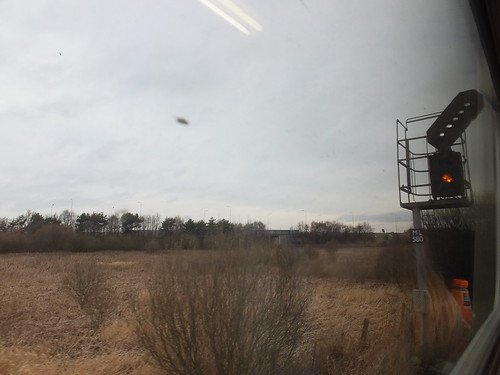 Approaching Bidston, my train gets a 'Yellow and a White Feather' for platform 2.
Approaching Bidston, my train gets a 'Yellow and a White Feather' for platform 2.
Running into platform 2 means that the train can arrive, crew can change ends, passengers get off and board and the train can depart without blocking platform 1 (the line towards Birkenhead) at all. Arriving in platform 1 fouls the line towards West Kirby until the train has arrived and the line towards Birkenhead is fouled until the train has drawn forward into the Stock Siding (part of a triangle which formerly allowed trains from West Kirby direct access to New Brighton). On leaving the Stock Siding, a trailing crossover allows Borderlands Line train into platform 2.
The not very pre-possessing station building actually has a decent waiting area, toilets and a small ticket office. By the time I'd bought my Merseyrail ticket to continue my travels, the Borderlands Line train had already left for Wrexham!
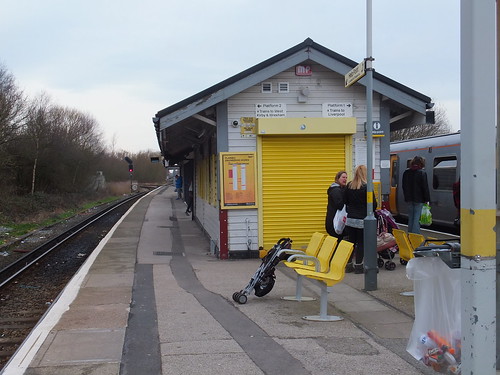 Bidston Station. The train I arrived on has already left platform 2 and a crowded electric train for Liverpool Central is arriving at platform 1.
Bidston Station. The train I arrived on has already left platform 2 and a crowded electric train for Liverpool Central is arriving at platform 1.
The rest of my journey is described in By rail to Liverpool (Part 2).
Book references
[1] 'Rail Centres: Shrewsbury' by Richard K. Morriss, published by Booklaw Publications (ISBN 1-901945-20-0).
[2] 'A Regional History of the Railways of Great Britain: Volume 11 North and Mid Wales by Peter E Baughan, published by David & Charles (ISBN 0-9153-7850-3).
Related articles on other sites
Wolverhampton to Shrewsbury Line (Wikipedia).
Shrewsbury to Chester Line (Wikipedia).
Borderlands Line (Wikipedia).
Borderlands Line.
Related posts on this site
By Rail to Chirk.
By rail to Liverpool (Part 2).
My pictures
Wolverhampton to Shrewsbury line.
Wellington.
Shrewsbury area railways.
Wrexham's Railways.
Borderlands Line.
Merseyrail.
[Link to part 2 added 5-Jun-2014]
